
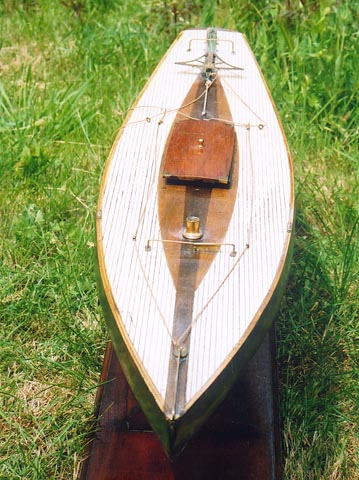
This is a boat of some quality and character, which I
bought from Michael Young's shop at the Angel in late 2000. I had gone with
the intention of looking more closely at a 1950s Marblehead that I had seen
in the window when the shop was shut, but I fell for this one instead. All
that Michael was able to tell me was that it had come from the Channel Islands
and was old.
I haven't done much with her since except try to work
out more of what she is and how she was built.
My conclusion that she is a model to the First International Rule of 1906
is based on the hull form, which is typical of boats to the Rule and in particular
on the characteristic 'hook' in the profile, which resulted from the clause
in the Rule that provided that the girth measurement should be taken at 55%
of the LWL and that the draught should not be less aft of this point than
it was at 55%. There was a similar provision in the immediately preceding
Linear Rating Rules of 1896 and 1901, but very few models were built to these
Rules and none are known to have survived. Models were built to the 1906 Rule
as 12-m 10-m and 8-m, all at a scale of 1:12, but there were no 6-m at that
time. She is too small to be a 12, and is very much the size of the later
6-m which were built at a scale of 1.66:12. During the 1920s the MYA ran a
combined metre class in which 8-m at 1:12 competed against 6-m at 1.66:12,
the boats being very much of a size. The fact that the sail carries a number
'8' may or may not related to her class, as it is clearly a club numbering
system, rather than part of the national registration procedure, which in
any case was not established until the 1920s.
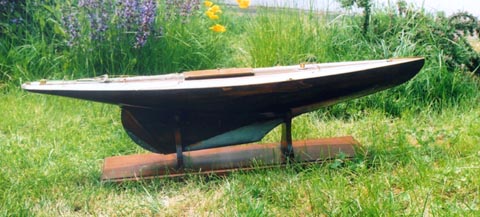
The hull appears to be entirely as built, give or take a few new bits of brass,
in particular the mast hole fitting, which looks very new and is small to
fit the aluminium alloy mast, which I am pretty sure is not the original fit.
I was so sure that this was a change from the original that I expected the
original mast hole to be somewhat bigger to take a heavier original mast in
wood. I was very surprised to find that the hole on the deck is no bigger
than that in the brass mast ferrule. The Bermuda rig cannot be the original
fit if the boat was indeed built before 1914, as I believe. Gaff rigs were
universal on models until after the 1914-18 war. The first published design
with Bermuda rig being by Bill Daniels for a 24 inch model published in Junior
Mechanics, an offshoot of Model Engineer, in 1914. The rig, though not, I
think, original, is of considerable age and has some unusual features, in
particular the use of metal clew fitting and a wooden plate at the head of
the jib.
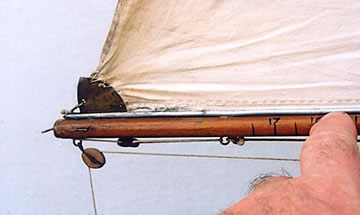
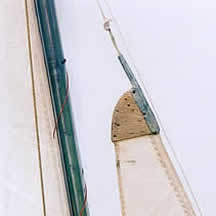
The planking is too dark to be mahogany, and looks like rosewood, but rosewood
is in general too brittle to be bent round the form of a model. I was flummoxed
by this until Gareth Morgan, who has wide experience of fine wood, suggested
that Santos rosewood, from Brazil is more supple than other types and is probably
the only rosewood that could be used for such a model.
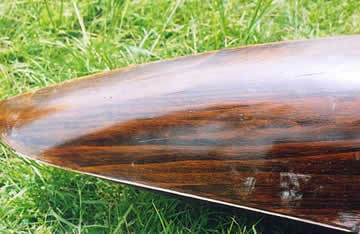

This again is a puzzle. The ribs take the form of ring frames incorporating
the deck beams and are cut from a very thin wood, not more than 1/16 inch,
and they are not plywood. They are clearly too fine for the planks to be pinned
or screwed to them, so the structure must be dependent on glue, though she
was built before glues that were in any sense water resistant. Despite this
the structure is very sound and there is nowhere where the planks can be seen
to be parting from the frames. The planking is lined with cotton cloth, probably
sail cloth, painted on, which will help with keeping the hull watertight,
but will not do much for its structural integrity. I am still at a loss to
understand exactly how the hull holds together, though it certainly does.
The deck is a work of art in itself, with a rosewood king plank, wide swept
centre pieces in mahogany and a painted deck pieces at each side. All is perfectly
jointed and the hatch cover, with its brass corners and elegant finial is
a lovely touch.


The beautifully crafted Braine gear may be a later addition, because it was
invented in London in 1904 and would have taken a while to spread beyond the
Metropolis. Daniels was invited to sail in the Channel Islands in 1913 and
expressed some surprise that by then all the boats in the islands had Braine
gear. Another reason for wondering whether the Braine gear is the original
fit is that the rudder has a very small lead weight incorporated. I have never
seen this on a Braine steered boat and it suggests that she may originally
have had a suite of weighted rudders, for which the raked sternpost would
have been ideally suited, and that the lightest of these was used when Braine
gear was fitted rather than make a new rudder. On second thoughts, had the
rudder now fitted been originally for use as a free swinging weighted rudder,
it would have been shorter than the stern post, so that it could have been
lifted off to be changed. So we still don't know why there is a little bit
of lead in the rudder.
The end of the mainsheet is fitted with a brass spring catch similar to those
used in jewellery. It looks too slight to hold up under the strains of real
sailing and I suspect that it is a fancy of which ever antique restorer gave
her the lovely sheen and bright brasswork she now displays.
Any further thoughts on the manifold mysteries of this beautiful boat gladly
received and considered.

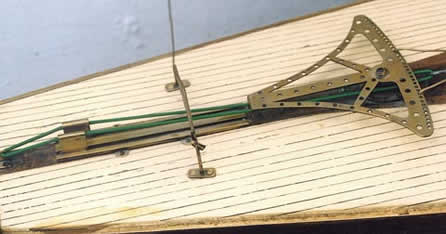
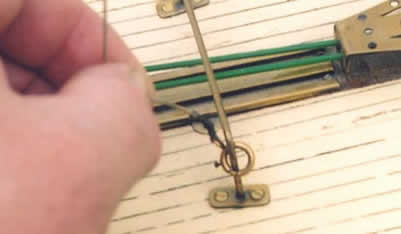
Russell Potts
| 